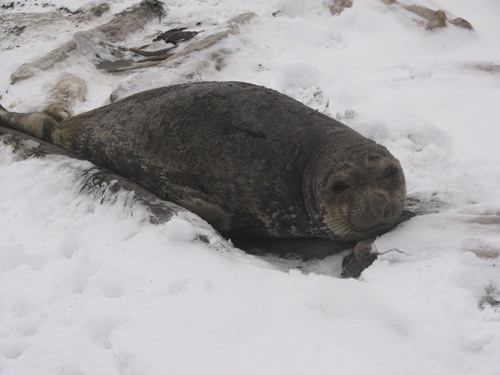By San Olson
Special to the Islands’ Weekly
As a marine mammal stranding volunteer, I received a call mid-January about a large seal seen on one of our southern beaches. Most sightings occur in summer, and usually involve harbor seal pups, so I suspected this could be a repeat of January, 2011 when a male elephant seal spent 10 days on Agate Beach.
Unsurprisingly, it was not a harbor seal. Lopez was experiencing another uncommon visitation, this time by a young female elephant seal that had chosen a driftwood strewn beach to start her annual molt. The very next day snow began to fall.
Elephant seals almost completely change their hair coat and the outer layers of skin once a year, usually in the spring or summer. “Lopez Elephant Seal Again” or LESA was way out of season. She looked disgusting and she smelled about the way she looked. Elephant seals occasionally use San Juan County beaches during molt, but most prefer the warmer climates of Mexico or California. Lolling around in the snow, I suspect she regretted her choice; those southern beaches are much more appealing.
None the less, she was ours to protect and observe for as long as she remained. Elephant seals stay ashore during molt, deriving calories from their blubber and creating all the water they need from fat metabolism. Fasting for long periods on shore is not unusual; females fast for three to four weeks while nursing pups and lose about 40 percent of their body mass. During breeding season, adult males are too busy defending territory and their harem to eat, but they have ample reserves, as they typically weigh around 4,000 pounds.
It’s possible LESA was born at Race Rocks, as over the past several years there have been a handful of pups born there. Along with other females, she should participate in her first migration to northern Hawaiian waters this summer. Males travel to the Aleutian Islands. She will spend much of her journey underwater, frequently diving to depths of 1800 feet, with very short surface intervals. It is nearly total darkness at that depth, so she would be using her large eyes, long whiskers and the bioluminescence of prey to find deep dwelling animals such as squid, eels, rays, or shrimp. Elephant seals make these migrations twice a year, returning to their birth beaches in winter to deliver and nurse pups and mate, returning to the beaches again for the summer molt.
She remained on the beach just four days and left when strong onshore winds and wave action caused driftwood collisions around her. LESA, as LES before her, was probably dissatisfied with our January climate. However, the recent warm spell might have suited her better and with the climate changing, we may be seeing more unusual visitors.
San Olson is a retired veterinarian and lives on Lopez Island. For more information about LESA or to become a marine mammal stranding volunteer, call Amy Traxler at the Whale Museum 378-4710, extension 27.




